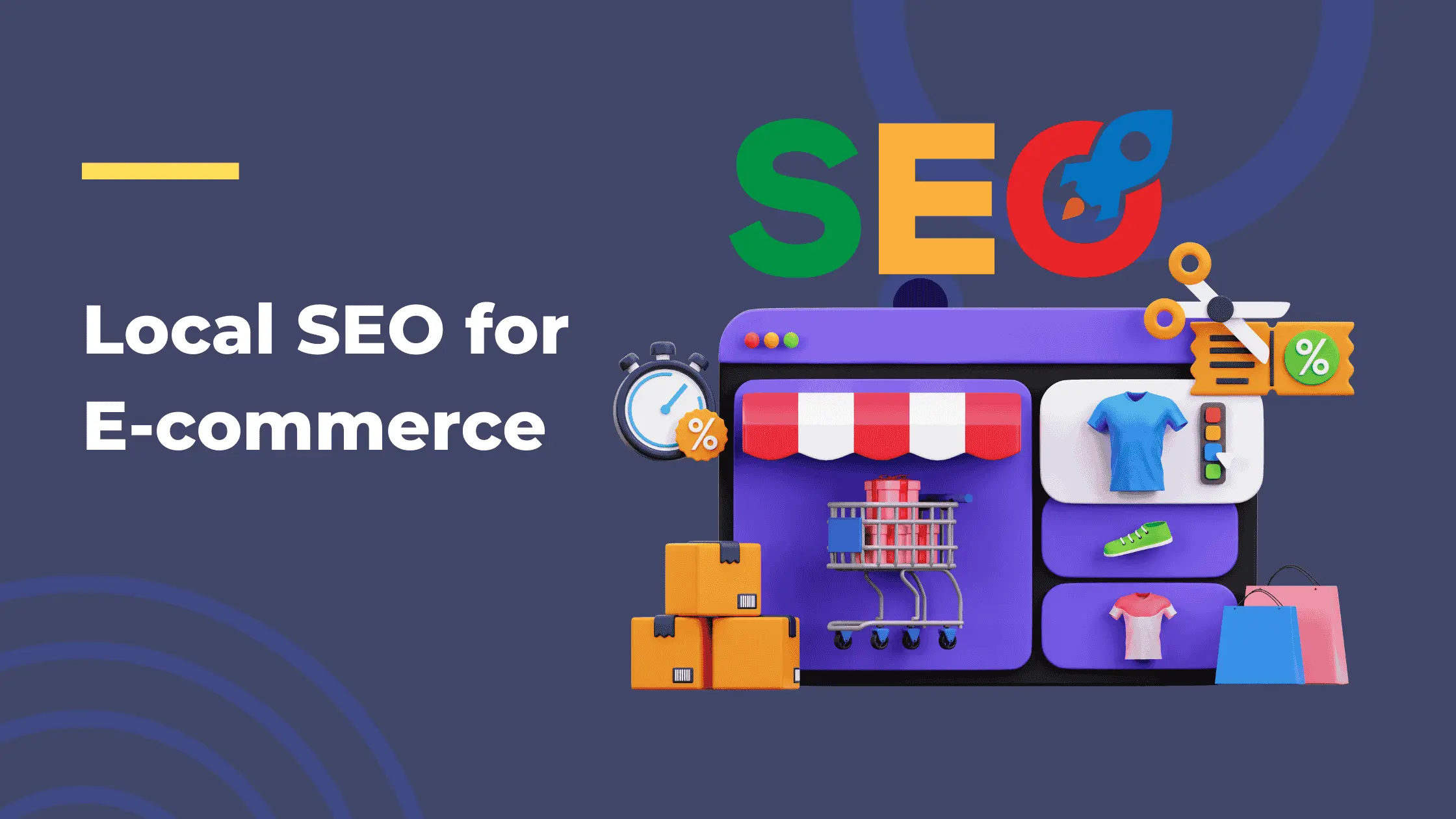In the fiercely competitive realm of online retail, attracting specific visitors to your virtual store is vital for achieving triumph. While global search engine optimization (seo) helps you reach a wide audience, local seo local seo for ecommerce is equally important for businesses aiming to attract customers in specific geographic areas. By fine-tuning your store to cater to local search, you can draw in more specific visitors, boost sales, and establish a loyal customer base in your region.
We’ll walk you through the key steps to mastering local seo for e-commerce in this comprehensive guide.

Table of Contents
Toggle1. What is Local SEO?
Local SEO, also known as search engine optimization, involves enhancing your online presence to attract more business from local searches. These searches happen on search engines like google and bing and focus on localized keywords, such as ‘buy shoes near me’ or ‘best coffee shop in [city name].’ for e-commerce businesses, especially those offering physical products, optimizing for local seo helps target customers who are looking for services or products within their geographical area.
2. Why Local SEO Matters for E-commerce
Even if you run an online store without a physical location, local search optimization can still be crucial in boosting your visibility. Here’s why:.
- Targeted traffic: local SEO helps attract visitors who are actively searching for your product or service in your area, which increases the likelihood of them making a purchase.
- Mobile search impact: According to Google, a staggering 76% of individuals who search for something nearby on their smartphones end up visiting a related business within a day, and a remarkable 28% of those searches lead to a purchase.
- Trust and credibility: being listed in local search results with positive reviews can help establish trust with potential customers.
- Competition: numerous e-commerce stores fail to optimize their websites for local search engine optimization, giving you a competitive advantage.
3. Steps to Optimize E-commerce Store for Local SEO
A. Claim and enhance your Google business profile.
The initial and crucial step in your local SEO strategy is to claim and enhance your Google Business Profile (GBP). Here’s what you should do:.
- If you haven’t already, create a Google Play account.
- Make sure to provide all the necessary details, such as your business name, address, phone number, website URL, and operating hours.
- Select the appropriate business categories to guarantee your business appears in relevant searches.
- Share top-notch images of your products, if you have a store, and any branding material you want to showcase.
- Encourage customers to share their experiences and regularly address both positive and negative feedback.
Tip: make sure that your business name, address, and phone number (nap) are the same on all platforms, such as social media and directories.
B. Optimize for local keywords.
Keyword research is a crucial aspect of SEO, and local SEO is no exception. Concentrate on local keyword phrases that are relevant to your specific location. Some strategies include:.
- Utilize tools such as Google Keyword Planner or SEMrush to identify keywords that have a local focus.
- Incorporate long-tail keywords such as ‘purchase [product] in [city]’ or ‘find affordable [service] in [city].’.
- Incorporate relevant local keywords in meta titles, descriptions, product listings, and image alt text.
Example: If you run an online store that sells pet supplies in Miami, your local keywords could be ‘pet supplies store in Miami’ or ‘buy dog food in Miami.’.
C. Generate content that is tailored to a particular location.
Creating content that is tailored to the specific needs and interests of your local community helps search engines recognize that your business is a valuable resource for local searches. Here’s how you can accomplish this:.
- Create blog articles or landing pages that focus on specific regions or cities, catering to the interests and needs of the local audience. For instance, ‘top-rated summer pet supplies in Miami.’.
- Emphasize local happenings and tailor content to appeal to the interests of the local community.
- Share success stories or testimonials from satisfied customers or clients from the local area.
Also checkout this one:
The Dos and Don’ts of Off-Page SEO Link Building in Competitive Industries
D. Cite local sources.
A local citation refers to any online mention of your business, including your name, address, and phone number, typically found in online directories. Make sure your business is included in prominent local directories like:.
- Yelp:
- Bing places.
- Yellow pages.
- Facebook is a social media platform that allows users to connect with friends, share content, and join groups.
- Foursquare:
A helpful tip: ensure that your nap information is consistent across all listings to prevent confusion and enhance your local search engine optimization (seo) rankings.
E. There are positive reviews of E.
- Customer reviews help build trust and are an important ranking factor. Encourage your customers to leave reviews on websites.
- Send follow-up emails after you buy something.
- Offer incentives for honest reviews.
F. Optimize for Mobile Users
- It’s important to maximize for mobile users.
- Ensuring that your website is mobile-friendly is important because most local searches are conducted on mobile devices. Key steps to make it easier to use a mobile device.
- A responsive design is used to adapt to different screen sizes.
4. How to Measure the Success of Your Local SEO Efforts
To assess whether your local SEO efforts are effective, it’s important to track essential metrics. Here are some tools and KPIs to consider:
- Google Analytics: Analyze traffic sources to see how much of your traffic originates from local searches.
- Google Search Console: Evaluate your site’s performance for local keywords.
- Google Business Profile Insights: Access detailed data on how many people found your business, clicked to your website, and requested directions.
- Review Metrics: Monitor the total number of reviews and the average rating across various platforms.
By keeping an eye on these metrics, you can pinpoint areas for improvement and modify your strategy as needed.
5. The Future of Local SEO for E-commerce
As local SEO evolves, e-commerce businesses should pay attention to emerging trends such as:
- Voice Search Optimization: With the increasing use of smart assistants, tailoring your content for voice search queries, which often have local intent, can keep you competitive.
- Hyperlocal Targeting: Focusing on customers in very specific areas, like neighborhoods or zip codes, can provide a competitive advantage.
- Artificial Intelligence and Local Search: AI is increasingly used to gauge search intent, so it’s essential that your website’s content offers clear and relevant information.
Conclusion
Local SEO serves as a highly effective strategy for e-commerce businesses aiming to attract targeted traffic. By implementing the steps outlined in this guide claiming your Google Business Profile, optimizing for local keywords, crafting location-specific content, and establishing local citations—you can enhance your local visibility and boost conversions. As you refine your local SEO efforts, keep an eye on your performance and stay informed about emerging trends to maintain a competitive edge.
Keep in mind that local SEO is a long-term approach, but the rewards are significant as you expand your e-commerce presence within your community and beyond.
References:
- Google. (n.d.). Think with Google: How Local Search Behavior Is Impacting Businesses. Retrieved from https://www.thinkwithgoogle.com/
- SEMrush. (2023). The Ultimate Local SEO Guide for Businesses. Retrieved from https://www.semrush.com/
- Search Engine Journal. (2023). Top Local SEO Strategies You Need to Know. Retrieved from https://www.searchenginejournal.com/
Checkout our new blogs:



